2009 FORD SUPER DUTY fuel
[x] Cancel search: fuelPage 14 of 103
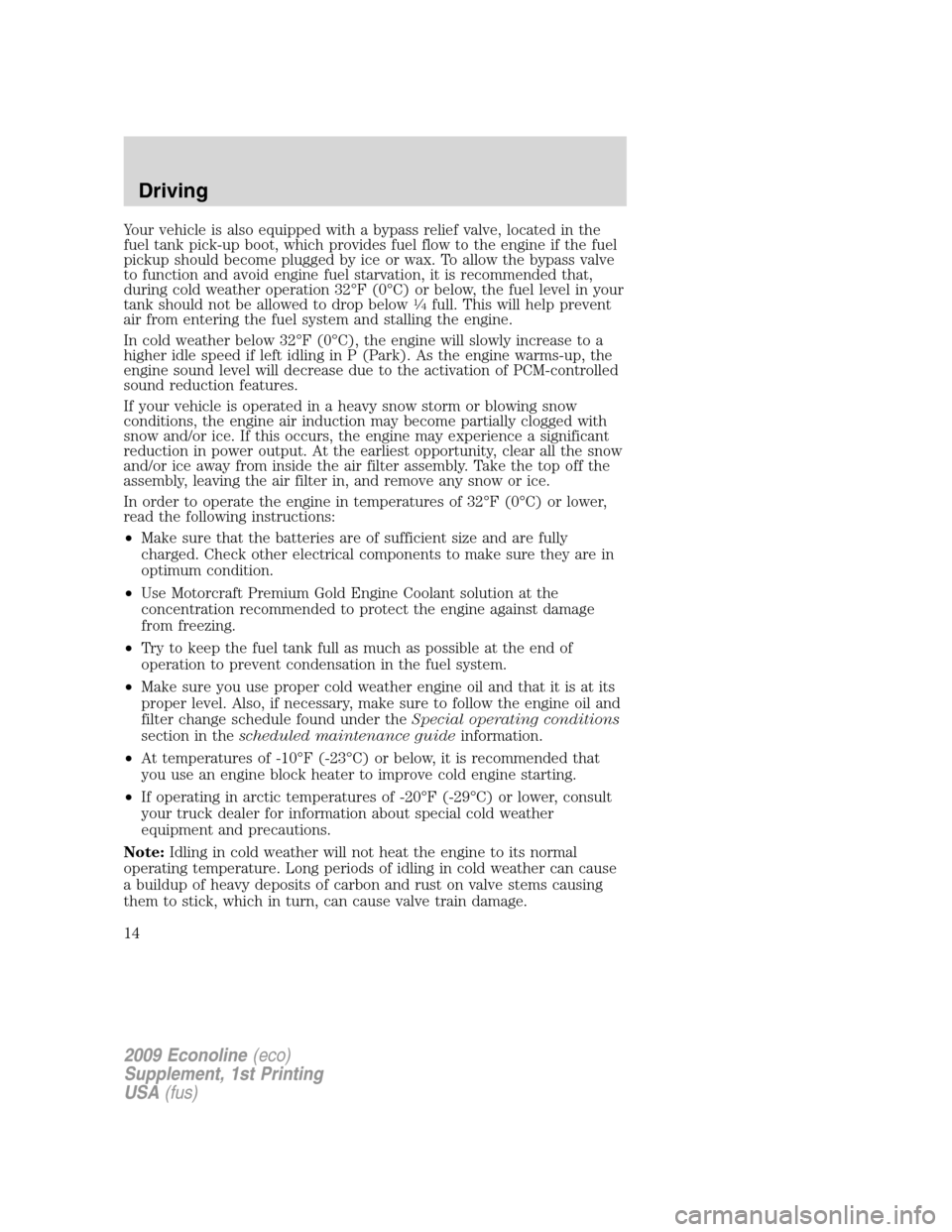
Your vehicle is also equipped with a bypass relief valve, located in the
fuel tank pick-up boot, which provides fuel flow to the engine if the fuel
pickup should become plugged by ice or wax. To allow the bypass valve
to function and avoid engine fuel starvation, it is recommended that,
during cold weather operation 32°F (0°C) or below, the fuel level in your
tank should not be allowed to drop below
1�4full. This will help prevent
air from entering the fuel system and stalling the engine.
In cold weather below 32°F (0°C), the engine will slowly increase to a
higher idle speed if left idling in P (Park). As the engine warms-up, the
engine sound level will decrease due to the activation of PCM-controlled
sound reduction features.
If your vehicle is operated in a heavy snow storm or blowing snow
conditions, the engine air induction may become partially clogged with
snow and/or ice. If this occurs, the engine may experience a significant
reduction in power output. At the earliest opportunity, clear all the snow
and/or ice away from inside the air filter assembly. Take the top off the
assembly, leaving the air filter in, and remove any snow or ice.
In order to operate the engine in temperatures of 32°F (0°C) or lower,
read the following instructions:
•Make sure that the batteries are of sufficient size and are fully
charged. Check other electrical components to make sure they are in
optimum condition.
•Use Motorcraft Premium Gold Engine Coolant solution at the
concentration recommended to protect the engine against damage
from freezing.
•Try to keep the fuel tank full as much as possible at the end of
operation to prevent condensation in the fuel system.
•Make sure you use proper cold weather engine oil and that it is at its
proper level. Also, if necessary, make sure to follow the engine oil and
filter change schedule found under theSpecial operating conditions
section in thescheduled maintenance guideinformation.
•At temperatures of -10°F (-23°C) or below, it is recommended that
you use an engine block heater to improve cold engine starting.
•If operating in arctic temperatures of -20°F (-29°C) or lower, consult
your truck dealer for information about special cold weather
equipment and precautions.
Note:Idling in cold weather will not heat the engine to its normal
operating temperature. Long periods of idling in cold weather can cause
a buildup of heavy deposits of carbon and rust on valve stems causing
them to stick, which in turn, can cause valve train damage.
2009 Econoline(eco)
Supplement, 1st Printing
USA(fus)
Driving
14
Page 18 of 103
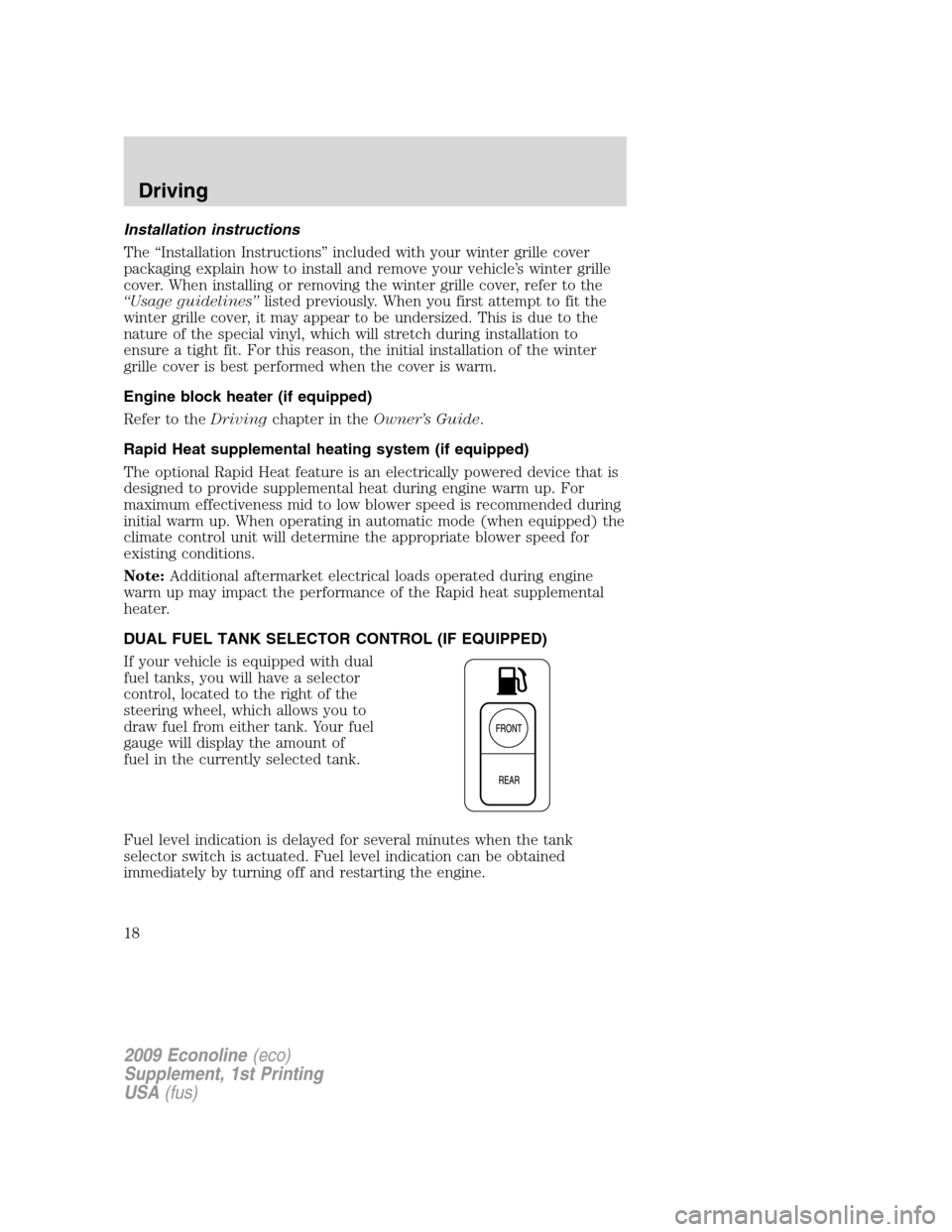
Installation instructions
The “Installation Instructions” included with your winter grille cover
packaging explain how to install and remove your vehicle’s winter grille
cover. When installing or removing the winter grille cover, refer to the
“Usage guidelines”listed previously. When you first attempt to fit the
winter grille cover, it may appear to be undersized. This is due to the
nature of the special vinyl, which will stretch during installation to
ensure a tight fit. For this reason, the initial installation of the winter
grille cover is best performed when the cover is warm.
Engine block heater (if equipped)
Refer to theDrivingchapter in theOwner’s Guide.
Rapid Heat supplemental heating system (if equipped)
The optional Rapid Heat feature is an electrically powered device that is
designed to provide supplemental heat during engine warm up. For
maximum effectiveness mid to low blower speed is recommended during
initial warm up. When operating in automatic mode (when equipped) the
climate control unit will determine the appropriate blower speed for
existing conditions.
Note:Additional aftermarket electrical loads operated during engine
warm up may impact the performance of the Rapid heat supplemental
heater.
DUAL FUEL TANK SELECTOR CONTROL (IF EQUIPPED)
If your vehicle is equipped with dual
fuel tanks, you will have a selector
control, located to the right of the
steering wheel, which allows you to
draw fuel from either tank. Your fuel
gauge will display the amount of
fuel in the currently selected tank.
Fuel level indication is delayed for several minutes when the tank
selector switch is actuated. Fuel level indication can be obtained
immediately by turning off and restarting the engine.
2009 Econoline(eco)
Supplement, 1st Printing
USA(fus)
Driving
18
Page 26 of 103

4. Make the final connection of the negative (-) cable to an exposed
metal part of the disabled vehicle’s frame or chassis, away from the
batteries.Do notuse fuel lines, brake lines, exhaust components or the
battery trays asgroundingpoints.
WARNING:Do not connect the end of the second cable to the
negative (-) terminal of the battery to be jumped. A spark may
cause an explosion of the gases that surround the battery.
5. Ensure that the cables are clear of moving parts or any fuel delivery
system, brake system or exhaust system parts.
Jump starting
1. Start the engine of the booster vehicle and run the engine at
moderately increased speed.
2. Start the engine of the disabled vehicle.
3. Once the disabled vehicle has been started, run both engines for an
additional three minutes before disconnecting the jumper cables.
2009 Econoline(eco)
Supplement, 1st Printing
USA(fus)
Roadside Emergencies
26
Page 32 of 103
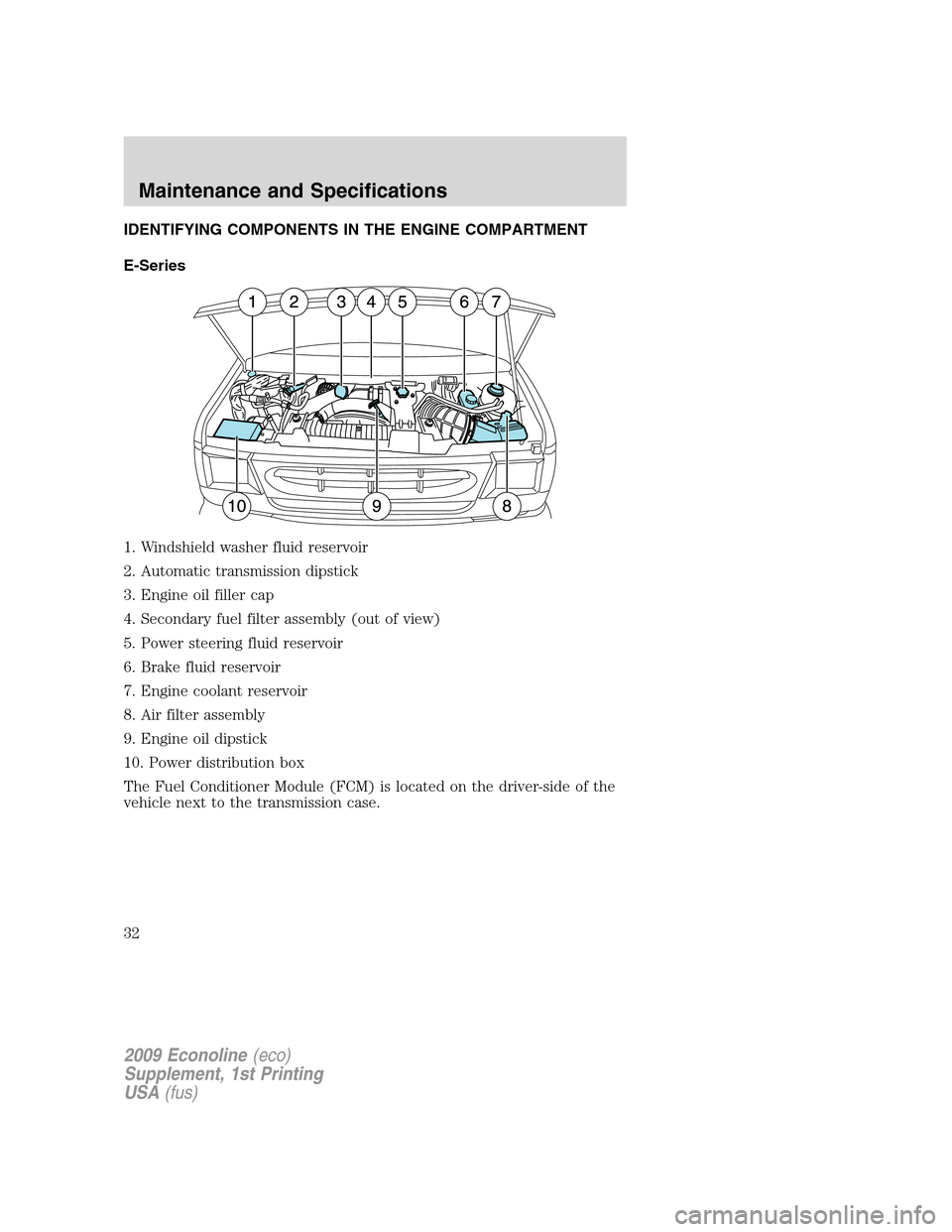
IDENTIFYING COMPONENTS IN THE ENGINE COMPARTMENT
E-Series
1. Windshield washer fluid reservoir
2. Automatic transmission dipstick
3. Engine oil filler cap
4. Secondary fuel filter assembly (out of view)
5. Power steering fluid reservoir
6. Brake fluid reservoir
7. Engine coolant reservoir
8. Air filter assembly
9. Engine oil dipstick
10. Power distribution box
The Fuel Conditioner Module (FCM) is located on the driver-side of the
vehicle next to the transmission case.
2009 Econoline(eco)
Supplement, 1st Printing
USA(fus)
Maintenance and Specifications
32
Page 33 of 103
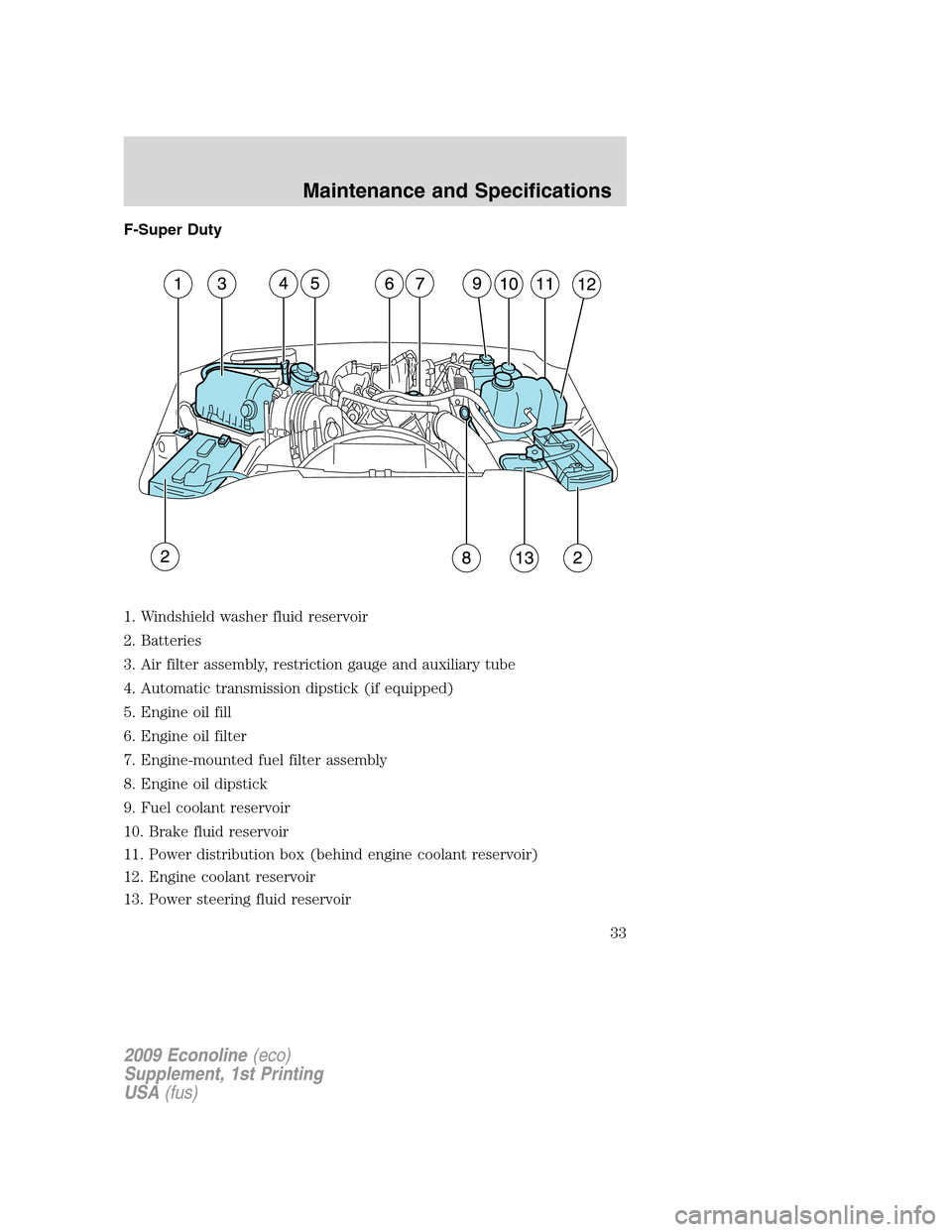
F-Super Duty
1. Windshield washer fluid reservoir
2. Batteries
3. Air filter assembly, restriction gauge and auxiliary tube
4. Automatic transmission dipstick (if equipped)
5. Engine oil fill
6. Engine oil filter
7. Engine-mounted fuel filter assembly
8. Engine oil dipstick
9. Fuel coolant reservoir
10. Brake fluid reservoir
11. Power distribution box (behind engine coolant reservoir)
12. Engine coolant reservoir
13. Power steering fluid reservoir
2009 Econoline(eco)
Supplement, 1st Printing
USA(fus)
Maintenance and Specifications
33
Page 34 of 103
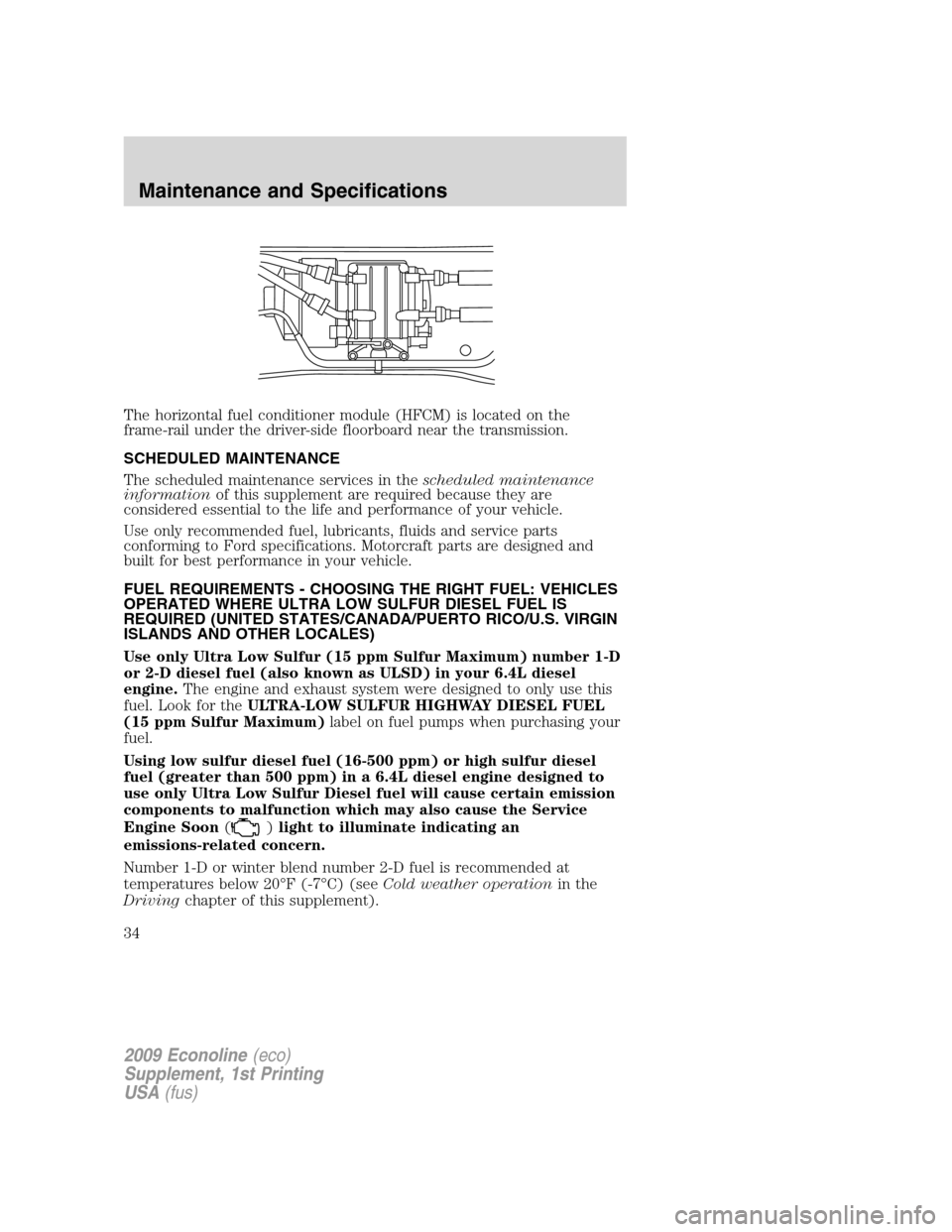
The horizontal fuel conditioner module (HFCM) is located on the
frame-rail under the driver-side floorboard near the transmission.
SCHEDULED MAINTENANCE
The scheduled maintenance services in thescheduled maintenance
informationof this supplement are required because they are
considered essential to the life and performance of your vehicle.
Use only recommended fuel, lubricants, fluids and service parts
conforming to Ford specifications. Motorcraft parts are designed and
built for best performance in your vehicle.
FUEL REQUIREMENTS - CHOOSING THE RIGHT FUEL: VEHICLES
OPERATED WHERE ULTRA LOW SULFUR DIESEL FUEL IS
REQUIRED (UNITED STATES/CANADA/PUERTO RICO/U.S. VIRGIN
ISLANDS AND OTHER LOCALES)
Use only Ultra Low Sulfur (15 ppm Sulfur Maximum) number 1-D
or 2-D diesel fuel (also known as ULSD) in your 6.4L diesel
engine.The engine and exhaust system were designed to only use this
fuel. Look for theULTRA-LOW SULFUR HIGHWAY DIESEL FUEL
(15 ppm Sulfur Maximum)label on fuel pumps when purchasing your
fuel.
Using low sulfur diesel fuel (16-500 ppm) or high sulfur diesel
fuel (greater than 500 ppm) in a 6.4L diesel engine designed to
use only Ultra Low Sulfur Diesel fuel will cause certain emission
components to malfunction which may also cause the Service
Engine Soon(
)light to illuminate indicating an
emissions-related concern.
Number 1-D or winter blend number 2-D fuel is recommended at
temperatures below 20°F (-7°C) (seeCold weather operationin the
Drivingchapter of this supplement).
2009 Econoline(eco)
Supplement, 1st Printing
USA(fus)
Maintenance and Specifications
34
Page 35 of 103
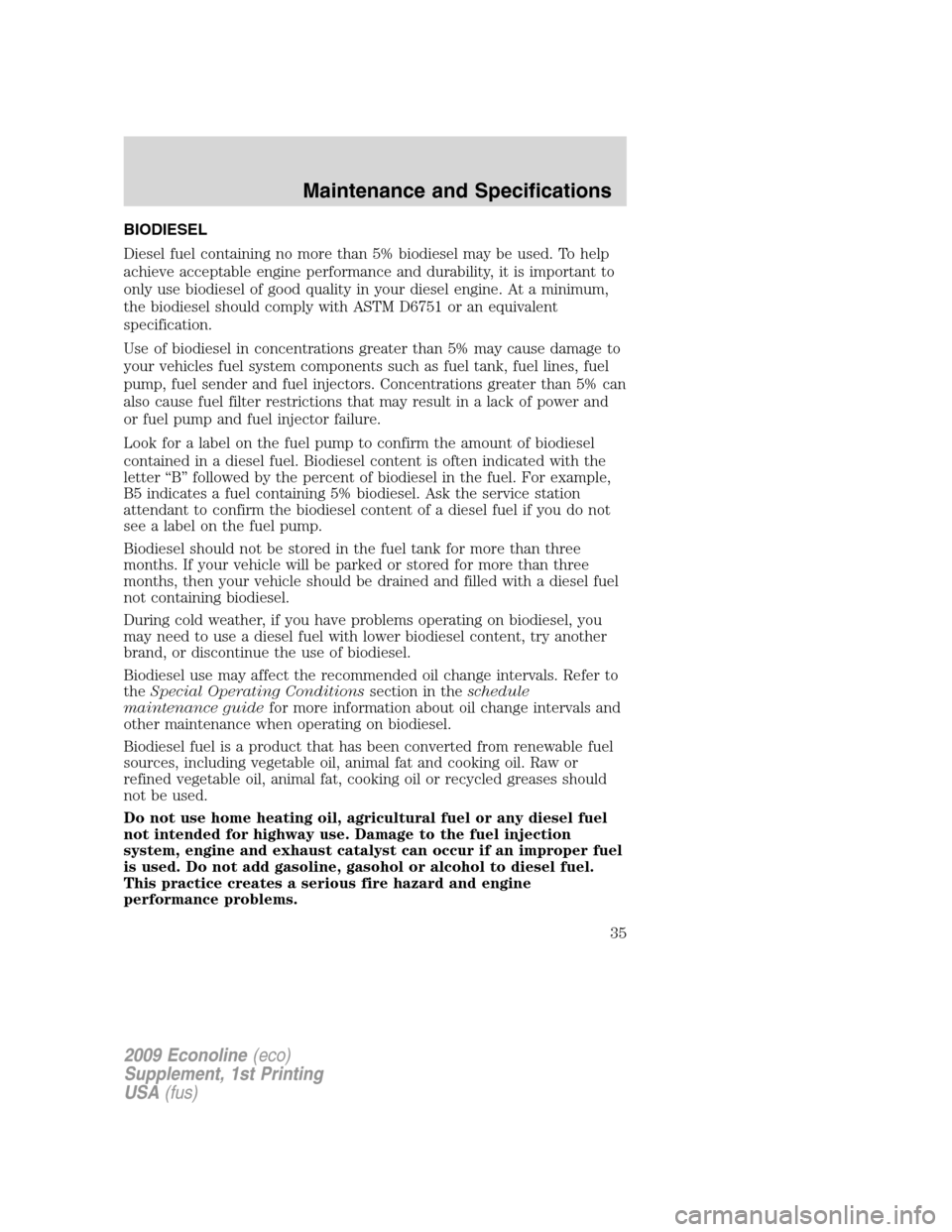
BIODIESEL
Diesel fuel containing no more than 5% biodiesel may be used. To help
achieve acceptable engine performance and durability, it is important to
only use biodiesel of good quality in your diesel engine. At a minimum,
the biodiesel should comply with ASTM D6751 or an equivalent
specification.
Use of biodiesel in concentrations greater than 5% may cause damage to
your vehicles fuel system components such as fuel tank, fuel lines, fuel
pump, fuel sender and fuel injectors. Concentrations greater than 5% can
also cause fuel filter restrictions that may result in a lack of power and
or fuel pump and fuel injector failure.
Look for a label on the fuel pump to confirm the amount of biodiesel
contained in a diesel fuel. Biodiesel content is often indicated with the
letter “B” followed by the percent of biodiesel in the fuel. For example,
B5 indicates a fuel containing 5% biodiesel. Ask the service station
attendant to confirm the biodiesel content of a diesel fuel if you do not
see a label on the fuel pump.
Biodiesel should not be stored in the fuel tank for more than three
months. If your vehicle will be parked or stored for more than three
months, then your vehicle should be drained and filled with a diesel fuel
not containing biodiesel.
During cold weather, if you have problems operating on biodiesel, you
may need to use a diesel fuel with lower biodiesel content, try another
brand, or discontinue the use of biodiesel.
Biodiesel use may affect the recommended oil change intervals. Refer to
theSpecial Operating Conditionssection in theschedule
maintenance guidefor more information about oil change intervals and
other maintenance when operating on biodiesel.
Biodiesel fuel is a product that has been converted from renewable fuel
sources, including vegetable oil, animal fat and cooking oil. Raw or
refined vegetable oil, animal fat, cooking oil or recycled greases should
not be used.
Do not use home heating oil, agricultural fuel or any diesel fuel
not intended for highway use. Damage to the fuel injection
system, engine and exhaust catalyst can occur if an improper fuel
is used. Do not add gasoline, gasohol or alcohol to diesel fuel.
This practice creates a serious fire hazard and engine
performance problems.
2009 Econoline(eco)
Supplement, 1st Printing
USA(fus)
Maintenance and Specifications
35
Page 36 of 103

FUEL REQUIREMENTS - CHOOSING THE RIGHT FUEL: VEHICLES
OPERATED WHERE ULTRA LOW SULFUR DIESEL FUEL IS NOT
REQUIRED
For a 6.4L engine to operate reliably on low sulfur or high sulfur diesel
fuel, the 6.4L engine must be a high sulfur configured engine or a ULSD
fuel-configured engine that has been retrofitted for high sulfur diesel fuel
use.
Use only a 6.4L diesel engine that has been configured for use
with high sulfur diesel fuel in markets with diesel fuel that has
sulfur content greater than 15 ppm. Using low sulfur diesel fuel
(16–500 ppm) or high sulfur diesel fuel (greater than 500 ppm) in
a 6.4L diesel engine designed to use only Ultra Low Sulfur Diesel
fuel increases the likelihood of engine oil dilution with fuel which
may lead to major engine damage. Engine damage from using the
improper type of fuel is not covered under your warranty.
Vehicles with 6.4L engines configured for use with high sulfur diesel fuel
will only be made available for sale in countries where ULSD fuel is not
available or mandated by the government. Vehicles originally sold in a
ULSD fuel market that are subsequently exported to non-ULSD fuel
markets will need to be retrofitted (at the customer’s expense) in order
to be reliably operated on non-ULSD fuel.
Vehicles equipped with a 6.0L engine that are operated in a market that
does not require ULSD fuel may be operated on higher sulfur fuel
without any engine fuel system or emissions-related concerns.
Number 1-D or winter blend number 2-D fuel is recommended at
temperatures below 20°F (-7°C) (seeCold weather operationin the
Drivingchapter of this supplement).
BIODIESEL
Diesel fuel containing no more than 5% biodiesel may be used. To help
achieve acceptable engine performance and durability, it is important to
only use biodiesel of good quality in your diesel engine. At a minimum,
the biodiesel should comply with ASTM D6751 or an equivalent
specification.
Use of biodiesel in concentrations greater than 5% may cause damage to
your vehicles fuel system components such as fuel tank, fuel lines, fuel
pump, fuel sender and fuel injectors. Concentrations greater than 5% can
also cause fuel filter restrictions that may result in a lack of power and
or fuel pump and fuel injector failure.
Look for a label on the fuel pump to confirm the amount of biodiesel
contained in a diesel fuel. Biodiesel content is often indicated with the
2009 Econoline(eco)
Supplement, 1st Printing
USA(fus)
Maintenance and Specifications
36